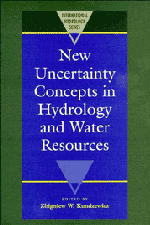Book contents
- Frontmatter
- Contents
- List of Authors
- Preface
- I INTRODUCTION
- II FACETS OF UNCERTAINTY
- 1 Bayesian relative information measure – a tool for analyzing the outputs of general circulation models
- 2 A stochastic weather generator using atmospheric circulation patterns and its use to evaluate climate change effects
- 3 Hydrological uncertainty – floods of Lake Eyre
- 4 Some aspects of hydrological design under non-stationarity
- 5 New plotting position rule for flood records considering historical data and palaeologic information
- III NOVEL APPROACHES TO UNCERTAINTY: FRACTALS, FUZZY SETS AND PATTERN RECOGNITION, NON-PARAMETRIC METHODS
- IV RANDOM FIELDS
- V TIME SERIES AND STOCHASTIC PROCESSES
- VI RISK, RELIABILITY AND RELATED CRITERIA
4 - Some aspects of hydrological design under non-stationarity
Published online by Cambridge University Press: 07 May 2010
- Frontmatter
- Contents
- List of Authors
- Preface
- I INTRODUCTION
- II FACETS OF UNCERTAINTY
- 1 Bayesian relative information measure – a tool for analyzing the outputs of general circulation models
- 2 A stochastic weather generator using atmospheric circulation patterns and its use to evaluate climate change effects
- 3 Hydrological uncertainty – floods of Lake Eyre
- 4 Some aspects of hydrological design under non-stationarity
- 5 New plotting position rule for flood records considering historical data and palaeologic information
- III NOVEL APPROACHES TO UNCERTAINTY: FRACTALS, FUZZY SETS AND PATTERN RECOGNITION, NON-PARAMETRIC METHODS
- IV RANDOM FIELDS
- V TIME SERIES AND STOCHASTIC PROCESSES
- VI RISK, RELIABILITY AND RELATED CRITERIA
Summary
ABSTRACT If hydrological systems and properties of their input are changing year to year the stationarity assumption of hydrological time series could not hold any longer. The non-stationarity may occur due to the global climate changes and continued man-induced transformations of river basins. The assumption is made that the time series of annual values of hydrological variables are non-stationary, which in fact can be tested statistically. Then the question arises how to use such series in hydrological design if the structure is to be dimensioned on the statistical base. It seems reasonable to try to extend the existing statistical procedure to cover such a case. Following this line it is proposed to keep the type of probabilistic distribution constant and to allow its parameters to vary in time. Estimation of time dependent parameters is described. Various hypotheses regarding the form of time dependence can be compared and significance of the dependence tested. In order for a hydraulic structure to be dimensioned, its period of life shall be defined, while probability of exceedance or economic risk shall refer to this period. If the same trend in the parameter change is to be preserved in future, it will enable extrapolation of parameter values to every year of the life period and then to evaluate the probability distribution for the whole period of life.
INTRODUCTION
Many works devoted to problems of the global climatic change and of the anthropopression within the scale of the drainage area, have appeared in recent years.
- Type
- Chapter
- Information
- Publisher: Cambridge University PressPrint publication year: 1995
- 4
- Cited by



